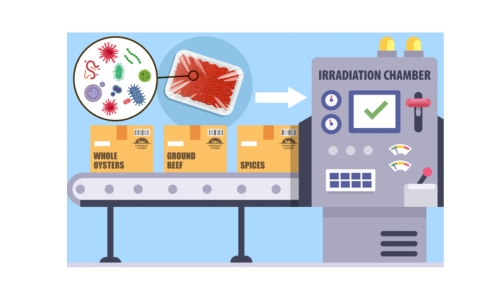INTRODUCTION
Irradiation of food is a processing and preservation method that produces outcomes comparable to pasteurisation or freezing. The product is exposed to radiation or ionising energy doses during this process. Irradiation increases a product’s shelf life at low levels. Insects, mould, bacteria, and other potentially hazardous microorganisms are killed during this process at greater concentrations.
It is permitted to irradiate food using three different forms of ionising radiation.
- The greatest energy of machine-produced electron beams is 10 million electron volts (MeV).
- X-rays produced by mechanical sources have a maximum energy of 5 MeV.
- Co-60 or Ce-137, with corresponding energies of 1.33 and 0.67 MeV, both generate gamma rays.
Forms of radiation
Electron beams
- The streams of extremely rapidly moving electrons created by electron accelerators are known as electron beams. Since they can only pierce a food product an inch and a half deep, electron beams are only used in specific situations for irradiating food.
- Shipping cartons (pre-packaged bulk food items) are not irradiated with electron beams due to poor penetration. Since mechanical sources produce electron beams, they can be turned on and off at will. The operator must be shielded.
X-rays
- X-rays are produced by machine sources, just like electron beams. Since they are photons, X-rays have far better penetration and can pass through food cartons. X-rays can also be turned on or off at will. Due to higher penetration, protection is a must.
Gamma rays
- Radioactive isotopes Cobalt-60 (Co-60) and Cesium-137 (Ce-137) emit gamma rays. Radioisotopes require shielding because, unlike electron beams and X-rays, they cannot be turned on or off voluntarily and continuously release gamma rays.
- When not in use, the Co-60 source is submerged in water and the lead-shielded Ce-137 source. Radioisotopes require periodic replenishment because they operate continuously. Since gamma rays consist of photons, they penetrate objects deeply [1].
Units of irradiation
The amount of radiation energy that is absorbed by food as it moves through the radiation field during processing is known as the radiation dose.
“Low” dosages, less than 1 kGy
- Eliminate pests from grains and fruits.
- Prevent tubers from sprouting.
- Postpone the ripening of some fruits and vegetables.
- Eliminate parasites from animal products (such asTrichinella spiralisin pork).
“Medium” dosages between 1 and 10 kGy
- EliminateE. coli,Salmonella, Shigella, Campylobacter, Yersinia, Listeria, and other pathogens from meat, poultry, and seafood.
- Stop the development of mouldon strawberries and other foods.
Higher than 10 kGy “high” dosages
- Kill pests and microbes on spices.
- Commercial sterilisationof food eliminates potentially harmful bacteria. The high dose finds its application inspecial diets for those with compromised immune systems [2].
Food Irradiation Procedure
- Ionising radiation is applied to the meal through gamma rays, a high-energy electron beam, or potent X-rays.
- X-rays and gamma rays are two types of radiation that resemble microwaves in some ways but have significantly greater energy and penetration.
- Like microwaves in a microwave oven, the rays travel through the meal, but the food does not significantly heat up. Food is not radioactive unless it has been exposed to gamma rays. Electricity, which can be turned on or off, creates electron beams and x-rays; radioactive material is unnecessary.
- In both situations, it is possible to eliminate the organisms that cause food to spoil, including insects, mould, and bacteria, some of which are significant sources of food poisoning [3].

Figure 1: Food products are sent to an irradiation chamber where a beam is passed through them [4]
Benefits of food irradiation
This method of food processing has several advantages, such as:
- Increased shelf life for some products;
- Decreased food spoilage;
- Decreased risk of food-borne illnesses like Campylobacter, Salmonella, E. coli, and Listeria (especially in meat, poultry, and fish);
- Less need for pesticides;
- Less need for some additives, like preservatives and antioxidants;
- Lower risk of importing or exporting insect pests concealed inside food products;
- Reduced need for pesticides.
Effects of irradiation
- Eggs and dairy products cannot be radioactively treated since the process alters their flavour or texture. It is possible to irradiate fruits, vegetables, grains, spices, and meats, including chicken.
- Irradiation causes only slight alteration in the chemical makeup of the food. However, it depletes some B-group vitamins and can decrease the number of nutrients in specific foods. Similar losses happen when food is prepared or preserved using more conventional and well-known techniques, including canning or blanching [1].





